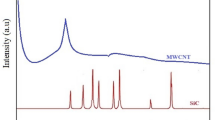Single- and multi-component sintering additives for aluminum oxide ceramics are presented. It was determined from the published data that because of their higher melting temperatures and the impossibility of simultaneously influencing a number of properties of the desired material single-component additives are less effective than multi-component additives. Because of synergy multi-component additives makes it possible to simultaneously improve the properties of sintered samples based on aluminum oxide, specifically, greater compaction (porosity about 0.1%) of the samples, sintering temperature reduction to 1400°C, preservation of a fine-crystalline structure (average grain size about 3 μm), higher crack resistance about 5.86 MPa · m1/2, and higher ultimate strength in bending about 600 MPa.


Similar content being viewed by others
References
V. L. Balkevich, Technical Ceramics [in Russian], Stroiizdat, Moscow (1984).
P. P. Budnikov,New Ceramics [in Russian], Stroiizdat, Moscow (1969).
A. M. Cherepanov and S. G. Tresvyatskii, Highly Refractory Materials and Products Made from Oxides [in Russian], Metallurgizdat, Moscow (1962).
G. Rossi and J. E. Burke, “Influence of additives on the microstructure of sintered Al2O3,” J. Am. Ceram. Soc., 56(12), 654 – 659 (1973).
D. N. Poluboyarinov, V. L. Balkevich, and R. Ya. Popilsky, High-Alumina Ceramic and Refractory Materials [in Russian], Gosstroiizdat, Moscow (1960).
M. Sathiyakumar and F. D. Gnanam, “Influence of MnO andTiO2 additives on density, microstructure, and mechanical properties of Al2O3,” Ceram. Int., 28, 195 – 200 (2002).
P. M. Pletnev, “Technology of producing corundum armor ceramics modified with complex additives,” Izv. Tomsk. Politekh. Univ., 326(3), 40 – 49 (2015).
Yu. A. Balinova, T. M. Scheglova, G. Yu. Lyulyukina, and A. S. Timoshin, “Particulars of α Al2O3 formation in polycrystalline fibers with a 99% aluminum oxide content in the presence of the additives Fe2O3, MgO, SiO2,”Tr.VIAM: Elektron. Nauch.-Tekhn. Zh., No. 3, Art. 03 (2014); URL: http://www.viam-works.ru (access date: 02/01/2019). DOI: 10.18577/2307-6046-2014-0-3-3-3.
K. L. Gavrilov, S. J. Bennison, K. R. Mikeska, and R. Levi- Setti, “Role of magnesia and silica in the alumina microstructure evolution,” J. Mater. Sci., 38, 3965 – 3972 (2003).
Aung Zhuo Moe, N. A. Popova, and E. S. Lukin, “Composite ceramics based on electrofused corundum with eutectic additive in the system Al2O3–TiO2–MnO,” Usp. Khim. Khim. Tekhn.,31(3), 10 – 12 (2017). 11. E. V. Malikova, Yu. K. Nepochatov, P.M. Pletnev, et al., “Effect of additions of yttrium and magnesium oxides on the characteristics of corundum armor ceramics,” Ogneup. Tekh. Keram., No. 4 – 5, 35 – 39 (2013).
Yu. K. Nepochatov, E. V. Malikova, P. M. Pletnev, and A. A. Bogaev, “Influence of complex additives on sintering and armor properties of corundum ceramics,” Ogneup. Tekh. Keram., No. 10, 14 – 19 (2013).
N. V. Sharova, N. A. Popova, and E. S. Lukin, “Ceramic from Al2O3 for substrates of integrated circuits,” Usp. Khim. Khim. Tekh., 30(7), 130 – 131 (2016).
D. V. Akinshin, A. V. Soloshchev, M. A. Vartanyan, and N. A. Makarov, “Studying the kinetics of sintering of corundum ceramics with the addition of eutectic composition,” Usp. khim. Khim. Tekh., 31(1), 91 – 93 (2017).
V. A. Voronov, A. O. Shvetsov, S. P. Gubin, et al., “Influence of the method of obtaining the cathode material with the composition LiNi0.33Mn0.33Co0.33O2 on the electrochemical characteristics of lithium-ion battery,” Zh. Neorg. Khim., 61(9), 1211 – 1217 (2016).
E. A. Kolesnikov, I. I. Puzik, N. N. Stepareva, et al., “The influence of synthesis conditions on the dehydration of aluminum oxide obtained by chemical precipitation,” Perspekt. Mater. No. 11, 316 – 320 (2011).
E. E. Nazarov, M. A. Vartanyan, and N. A. Makarov, “Convective drying as a method of producing xerogel for the synthesis of sintering additives by the sol-gel method,” Usp. Khim. Khim. Tekh., 31(3), 75 – 77 (2017).
N. E. Kotlovanova, A. N. Matveeva, Sh. O. Omarov, et al., “Formation and acid properties of the surface of finely dispersed η-Al2O3 nanopowders,” Neorg. Mater., 54(4), 410 – 418 (2018).
A. E. Sychev and A. G. Merzhanov, “Self-propagating high-temperature synthesis of nanomaterials,” Usp. Khim. Khim. Tekh., No. 73(2), 157 – 170 (2004).
A. G. Tarasov, V. A. Gorshkov, and V. I. Yukhvid, “Phase composition and microstructure of solid solutions of the Al2O3–Cr2O3 system obtained by the method of self-propagating high-temperature synthesis,” Neorg. Mater., 43(7), 819 – 823 (2007).
K. C. Patil, M. S. Hegde, and Tanu Rattan, Chemistry of Nanocrystalline Oxide Materials Combustion Synthesis, Properties and Applications, World Scientific Publishing Co. Pte. Ltd., Singapore (2008), pp. 42 – 58
Author information
Authors and Affiliations
Corresponding author
Additional information
Translated from Steklo i Keramika, No. 8, pp. 14 – 21, August, 2019.
Rights and permissions
About this article
Cite this article
Tkalenko, D.M., Voronov, V.A. Synthesis, Structure, and Properties of Single- and Multicomponent Additives for Aluminum Oxide Based Ceramic Materials (Review). Glass Ceram 76, 290–296 (2019). https://doi.org/10.1007/s10717-019-00186-3
Published:
Issue Date:
DOI: https://doi.org/10.1007/s10717-019-00186-3




